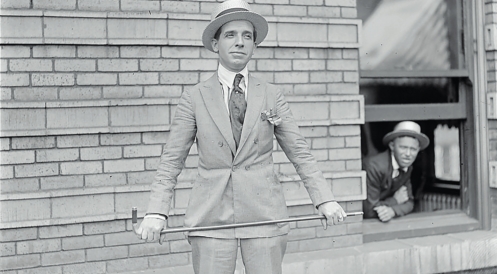
Photo: Courtesy of Digital Commonwealth One hundred two years ago this month, Downtown Boston was the epicenter of history’s most infamous financial crime.
Charles Ponzi launched the fraud that would make his name synonymous with white collar malfeasance in January 1920 from his office on School Street, above what is now a Starbucks next to Old City Hall. Ponzi bilked victims in Boston and beyond out of what today would be hundreds of millions of dollars before his exposure and eventual prosecution. Yet a century later, the details of the original Ponzi scheme and its impact on Bostonians have largely been forgotten.
By
the time he settled in Boston in 1917, the Italian born Ponzi was
already an established con man who served prison time in both Atlanta
and Montreal. He came to Boston ostensibly for a fresh start, marrying
the daughter of a local produce distributor and eventually taking over
his business. But the company failed within a year, leaving Ponzi
penniless and in debt. It didn’t take long for the former scammer to
turn to less legitimate means of income.
Ponzi’s
scheme centered around an obscure postal service voucher called an
“international reply coupon (IRC),” which could be redeemed for a
postage stamp in both the US and throughout Europe. He told investors he
would purchase IRC’s in Italy, where postal rates were much lower, then
resell them in the US for a 50% profit.
There
is little evidence that Ponzi ever purchased a single IRC. Charming and
manipulative, he pitched his bogus investment opportunity throughout
Boston’s Italian community, using money from new investors to pay out
fraudulent dividends to existing clients.
Word
spread quickly about the financial wizard providing 50% returns, and
soon Bostonians of all stripes were clamoring to give Ponzi their money.
By March, he was bringing in nearly a million dollars a month.
“The
cash is coming in so fast that they have bags in the office that they
are filling up with cash,” Suffolk University history professor and
Ponzi expert Robert Allison told the Smithsonian Institution in 2016.
“The police have to hire special details to keep track of what’s
happening on School Street because you have these crowds of people
coming in either to invest with Ponzi or get paid by Ponzi.”
Not
everyone was fooled. Financial journalist Clarence Barron identified
Ponzi as a fraud, but his exposé was so steeped in xenophobic language
that it actually promoted further investment throughout Boston’s
immigrant communities. “[Barron] sees through it almost immediately, but
then he says, ‘Well of course you couldn’t expect someone like Ponzi to
understand banking because he’s an uneducated Italian,’” Allison told
the Smithsonian. “If you’re an uneducated Italian, you now know you have
to show your solidarity by investing with Ponzi to show this Barron
guy.”
Others soon
caught on. An article in <The Boston Post> proved that there were
not enough IRC’s in the world to generate the amount of income Ponzi
claimed to generate. Just six months after Ponzi lured his first
customers, his scheme crumbled. He would spend years in a Massachusetts
jail before being deported, dying impoverished in Brazil.
In
those six short months, Ponzi created a trail of financial ruin that
sent shockwaves through the city. Six banks shuttered in the wake the
scheme’s collapse, and hundreds of Bostonians, from recent immigrants to
Brahmins, faced financial ruin. Seventy percent of the Boston police
force was estimated to have lost money in the scam. A century after he
enticed his first victims, Ponzi’s name lives on in infamy, even if his
connection to Downtown has largely faded from memory.